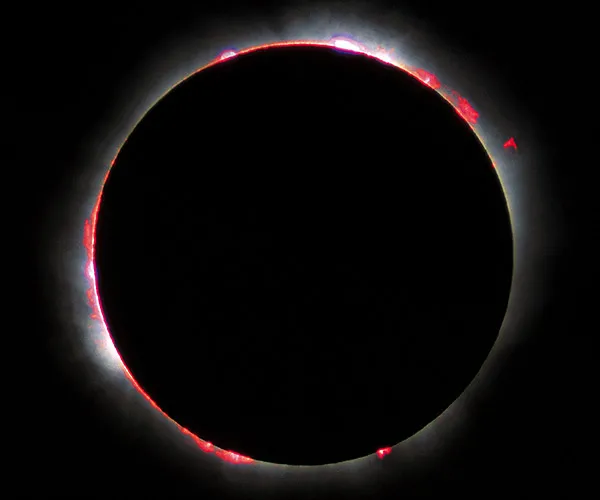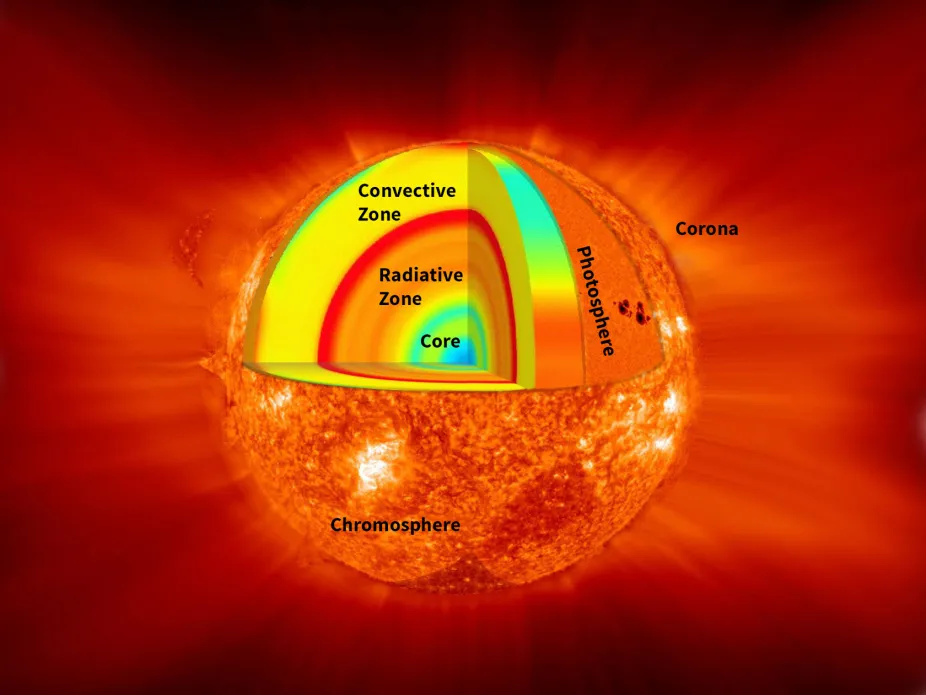The Colorful Chromosphere: Sun’s Lower Atmosphere

The colorful chromosphere is seen shining out around the edges of the Moon when viewed during a total solar eclipse, when the bright surface of the Sun is blocked.
Luc Viatour/ HAO
The lower region of the Sun's atmosphere is called the chromosphere. It was named after the Greek root chroma (meaning color). The chromosphere appears bright red because the hydrogen in the Sun emits a reddish-colored light at high temperatures.
The chromosphere is a thin layer of plasma that lies between the Sun’s visible surface (the photosphere) and the corona (the Sun’s upper atmosphere). It extends for at least 2,000 km (1,200 mi.) above the surface. The chromosphere is normally hidden from our view; its light is drowned out by the brilliance of the underlying photosphere. We can observe the chromosphere with special telescopes on satellites or during a solar eclipse.
Plasma Storms and Solar Phenomena Originate in the Chromosphere
Similar to the troposphere of our own planet Earth, the chromosphere is full of complex storms and other phenomena - though in the chromosphere the storms are made of plasma. Magnetic fields that form near the Sun’s surface extend upwards, throughout the chromosphere, releasing energy and stirring up the chromospheric plasma. Solar prominences and filaments are some of the most common features of the solar atmosphere. These looping arches of plasma rise up through the chromosphere into the corona.
Things Heat Up in the Chromosphere
The temperature of the chromosphere varies in curious patterns as you travel up from the surface of the Sun. For the first couple hundred kilometers, the temperature drops from roughly 6,000 °C to about 4,000 °C (11,000 °F to 7,200 °F). Then, in the upper levels of the chromosphere, temperatures begin to climb, reaching tens of thousands of degrees. A thin transition region forms the border between the chromosphere and the corona above it. Temperatures rise very quickly in the transition region, from about 14,000 °C to more than a million degrees.

The interior layer of the Sun includes the core, radiative zone, and convective zone. The photosphere is the surface layer of the Sun, and the solar atmosphere includes the chromosphere and corona.
SOHO (ESA & NASA)
Scientists aren't completely sure why temperature increases with height in the upper chromosphere. Because heat is generated in the Sun’s core, we would expect temperatures to drop as you move farther from the center of the Sun. NASA scientists have observed solar seismic waves of plasma that travel up through sunspots on the surface and continue traveling through the chromosphere and into the corona, being twisted and spiraled into explosive regions by magnetic fields along the way. This movement of energy through the chromosphere provides clues to help understand how the Sun’s atmosphere is heated to such high temperatures.